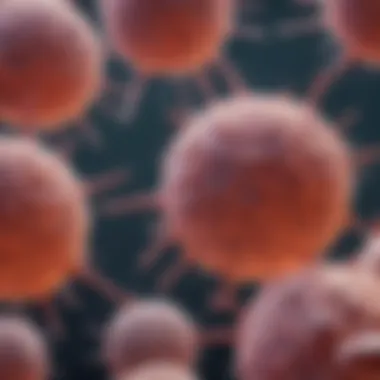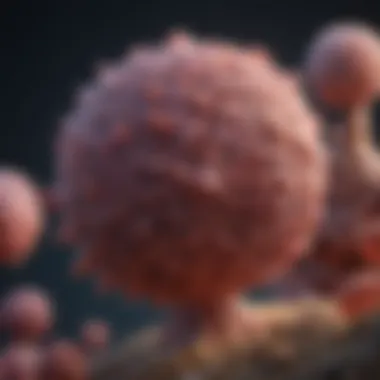Understanding Cancer Cell Biology: Mechanisms and Impacts


Intro
Understanding cancer cell biology is like peeling an onion; each layer reveals complexity and nuance that can be difficult to digest. As we dive into the world of cancer, we encounter a harsh reality: cancer cells aren't mere rogue entities but are deeply intertwined within biological networks. They exploit normal cellular processes once intended for growth, repair, and functionality. This article serves as a guide to navigating the challenges presented by these tenacious cells.
Our exploration encompasses several pivotal aspects such as how cancer cells diverge from their normal counterparts, the role of genetics and the ever-critical tumor microenvironment. We’ll also discuss how these dynamics connect to contemporary treatment strategies and future research avenues that aim not just for survival but also for improving quality of life for patients. By illuminating these critical areas, we aim to equip readers—students, researchers, educators, and professionals—with a more profound understanding of the biological intricacies involved.
Key Findings
Summary of the Main Results
The nuances pertaining to cancer cell biology yield several findings that stand out:
- Altered Metabolism: Cancer cells often demonstrate enhanced glycolysis, utilizing glucose more aggressively even in the presence of oxygen, known as the Warburg effect.
- Genetic Mutations: Identifiable mutations in genes like TP53 and KRAS play pivotal roles in tumorigenesis, impacting both development and therapeutic resistance.
- Tumor Microenvironment: This environment is not just passive; it comprises immune cells, extracellular matrix components, and signaling molecules that collectively influence cancer progression.
- Angiogenesis: Many tumors have the ability to stimulate blood vessel growth, ensuring a steady supply of nutrients, further complicating treatment options.
Each of these points emphasizes the multifaceted nature of cancer cells and how they orchestrate their survival and proliferation within the body.
Significance of Findings Within the Scientific Community
These findings have significant implications. The identification of specific genetic markers allows for personalized medicine approaches, where treatments can be tailored to the genetic profile of a patient's tumor. Moreover, a better understanding of the tumor microenvironment opens avenues for therapies that target not just the tumor cells themselves but the support system that allows them to thrive.
"Understanding the hallmarks of cancer cell biology is key to developing innovative treatments that can effectively outsmart these cells."
Implications of the Research
Applications of Findings in Real-World Scenarios
The principles derived from the study of cancer cell biology extend beyond the laboratory. For instance, insights into altered metabolic processes open doors to novel dietary strategies tailored to deprive cancer cells of their preferred energy sources. Furthermore, understanding how tumors manipulate their microenvironment informs the design of combination therapies that can better intercept cancer growth.
Potential Impact on Future Research Directions
Ongoing research continues to uncover additional pathways that cancers exploit, suggesting that future treatments will increasingly focus on precision oncology. The use of emerging technologies, such as CRISPR for gene editing, holds promise in correcting mutations at their source. Moreover, the exploration of the gut microbiome’s influence on cancer progression posits another layer of understanding that could dramatically shift treatment paradigms.
Prologue to Cancer Cell Biology
Understanding cancer from a cellular standpoint is crucial for anyone delving into the intricate world of oncology. Cancer cell biology not only sheds light on the fundamental differences between cancerous and normal cells, but it also paves the way for effective treatments. The study of cancer cells reveals how these cells proliferate uncontrollably and bypass the usual cellular regulations. Moreover, this knowledge helps in identifying potential therapeutic targets, ultimately contributing to the advancement of oncology and regenerative medicine.
In this section, we explore critical elements, such as the cell cycle, apoptosis, and genetic mutations. These elements are vital for a comprehensive grasp of cancer biology. They help shine a light on why certain cells behave erratically and how they undermine the body's natural processes. Let's dive into defining cancer to appreciate its complexities and quirks.
Defining Cancer: A Cellular Perspective
From a cellular view, cancer can be pinpointed as an ailment of growth regulation. When we think about typical cells, they follow a well-regulated cycle: they grow, divide, and undergo a process called apoptosis, which is just a fancy term for programmed cell death. This cycle is orchestrated by a multitude of signaling pathways and genetic controls. However, cancer cells manage to elude these checks and balances, leading to uncontrolled proliferation. It's as if they turn off the proverbial "stop" signs on their way to multiply.
There are different types of cancer, each originating from various cell types. For instance, carcinoma arises from epithelial cells, while sarcomas emerge from connective tissues. It's important to note that while we talk about cancer in a broad sense, the specifics can vary widely, complicating treatment approaches.
Historical Context and Discovery
The story of cancer's discovery is a long and winding road that dates back thousands of years. Ancient Egyptian texts highlighted tumors, while Hippocrates coined the term "carcinos" around 400 B.C. However, it wasn't until the 19th century that significant strides were made in understanding cancer. Notably, Rudolf Virchow's work linked the origins of cancer to cellular abnormalities. He argued that all diseases begin at the cellular level.
As researchers continued to peel back cancer's layers, the 20th century saw a surge of advancements. The discovery of oncogenes and tumor suppressor genes by scientists such as Harold Varmus and David Baltimore in the 1970s provided profound insights into how certain genes can turn ordinary cells into cancerous ones. These breakthroughs exemplified the shift from observational studies to molecular biology in understanding cancer. This foundation is key for the discussions that follow in this article, where we unpack more nuanced details about cancer biology.
Fundamental Concepts in Cancer Biology
The realm of cancer cell biology is complex, with fundamental concepts laying the groundwork for understanding how cancer develops and progresses. This section emphasizes crucial elements that define cancer's behavior on a cellular level. Key topics such as cell cycle regulation, mechanisms of apoptosis, and the impact of genetic mutations form the backbone of research and therapeutic development in oncology. Recognizing these fundamental concepts not only enhances our grasp of cancer biology but also supports advancements in treatment strategies that could ultimately improve patient outcomes.
Cell Cycle Regulation
The cell cycle is a series of phases that cells navigate to grow and divide. This cycle is tightly regulated by a variety of proteins, including cyclins and cyclin-dependent kinases (CDKs). When functioning properly, this regulation ensures orderly cell division, preventing uncontrolled proliferation that characterizes cancer. For instance, mutations in genes responsible for these regulatory proteins can lead to lax control over the cell cycle and result in tumor formation.
Through studies exploring specific checkpoints within the cycle, researchers have uncovered critical insights. The G1/S checkpoint, for example, serves as a gatekeeper, deciding whether the cell should proceed with division. Disruption at this stage, often a result of genetic mutations, can lead to malignant transformation.
"A malfunction at any checkpoint can tip the balance from normal cell division to malignant growth."
Understanding these regulatory mechanisms opens the door to potential therapeutic targets. By restoring proper regulation, there’s hope for developing interventions that could selectively halt tumor growth without harming normal cells.
Apoptosis and Cell Survival Mechanisms
Apoptosis, or programmed cell death, plays a vital role in maintaining cellular homeostasis. Cancer cells often acquire the ability to evade apoptosis, allowing them to survive under conditions where normal cells would die. Mechanisms that facilitate this survival include upregulation of anti-apoptotic proteins like Bcl-2 and downregulation of pro-apoptotic factors such as Bax.
The interplay between apoptosis and cell survival pathways is intricate. The balance between these opposing forces is critical in determining whether a cell will thrive or perish. For instance, cancer therapies that induce apoptosis can be effective in targeting resistant cancer cells. However, the challenge lies in overcoming the survival signals that these cells constantly engineer in their favor.


Understanding how cancer cells manipulate these processes provides insights for new treatments aimed at reinstating apoptosis in tumor cells.
Genetic Mutations and Their Consequences
Mutations in genetic material are a foundation of cancer development. They can arise spontaneously during DNA replication or be induced by external factors like radiation and certain chemicals. These genetic alterations lead to changes in protein function, which can drive the cancerous process. Oncogenes, which promote cell growth, can become hyperactive, while tumor suppressor genes that normally act to inhibit cell proliferation may be deactivated.
Notably, the well-studied mutation of the TP53 gene illustrates the impact of genetic changes in cancer biology. The TP53 protein typically plays a role in enforcing genomic integrity; however, when mutated, it loses its ability to regulate the cell cycle and promote apoptosis, leading to unchecked cell division and cancer progression.
The consequences of these mutations are profound and multifaceted, impacting not only tumor behavior but also the response to therapies. Furthermore, the advent of genomic sequencing technologies has yielded a treasure trove of data, enabling scientists to identify specific mutations that could be targeted with precision therapies.
In summary, comprehending the fundamental concepts in cancer biology highlights the nuances of cell behavior and the molecular underpinnings of cancer. This knowledge paves the way for innovative research and therapeutic strategies, ultimately contributing to the fight against cancer.
The Tumor Microenvironment
The tumor microenvironment plays a vital role in the development and progression of cancer. This unique ecosystem consists of not just the tumor cells themselves but also various non-cancerous cells, signaling molecules, and the extracellular matrix that surrounds and supports the tumor. Understanding the tumor microenvironment is crucial because it can greatly influence tumor behavior, therapeutic responses, and patient outcomes.
In analyzing the complexities of cancer biology, the tumor microenvironment presents layers of interactions. From the communication between cancer cells and stromal cells to the influence of immune components, each element contributes to the unique characteristics of the tumor. Specifically, the microenvironment can either promote tumor growth or help suppress it, making it a double-edged sword in cancer progression.
Cellular Interactions Within Tumors
Cellular interactions within the tumor microenvironment are diverse and complex. Tumor cells are not isolated; rather, they engage with a myriad of other cells, including fibroblasts, immune cells, and endothelial cells. This crosstalk strengthens tumor survival, migration, and expansion. For instance, cancer-associated fibroblasts (CAFs) can secrete growth factors that support tumor growth, while immune cells may alter their usual responses to become supportive of tumor progression instead of fighting against it.
- Key players in these interactions include:
- Fibroblasts: Secrete collagen which contributes to the stiffness of the tumor.
- Macrophages: Can either attack or assist cancer cells based on their polarization state.
- Endothelial cells: Help form new blood vessels through angiogenesis, supplying the tumor with nutrients.
Each of these interactions illustrates how dynamic and interactive the tumor microenvironment is, with potential implications for targeted therapies that manipulate these cellular relationships.
Role of Extracellular Matrix
The extracellular matrix (ECM) is more than just a supporting structure; it is instrumental in signaling and regulating cellular functions. Composed mostly of proteins and polysaccharides, the ECM provides a scaffold that affects cell adhesion, migration, and even differentiation. In the context of cancer, the ECM can become altered, leading to enhanced tumor invasion and metastasis.
Some notable aspects include:
- Stiffness and Composition: The ECM can become significantly stiffer due to increased collagen deposition, which is often observed in many solid tumors. This stiffness can aid in tumor progression by promoting a more aggressive phenotype.
- Proteolytic Remodeling: Enzymes like matrix metalloproteinases can degrade the ECM, allowing cancer cells to invade surrounding tissues.
Understanding how the ECM interacts with cancer cells can pave the way for novel therapeutic strategies aimed at normalizing the tumor microenvironment.
Immune Evasion Strategies
A critical aspect of the tumor microenvironment is its ability to evade immune detection and response. Cancer cells develop various strategies to escape the immune system, which plays a crucial role in tumor survival.
Some common immune evasion tactics include:
- Immune checkpoint expression: Tumor cells can express proteins like PD-L1, which inhibit T-cell activation.
- Cytokine production: Tumors may release cytokines that suppress immune responses or recruit immune cells that support tumor growth rather than attack it.
- Altered antigen presentation: Changes in the way cancer cells present antigens can mislead immune cells, preventing an effective attack.
Recognizing these immune evasion strategies can direct the development of innovative immunotherapies, which leverage the immune system to target cancer more effectively.
Ultimately, understanding the tumor microenvironment and its components can significantly impact our therapeutic approaches and clinical outcomes in cancer treatment.
Mechanisms of Cancer Progression
Understanding the mechanisms of cancer progression is crucial for both basic research and clinical implications. These mechanisms explain how normal cells transform into malignant ones, highlighting processes that can offer insight into new therapeutic strategies or biomarkers for diagnosis. The progression of cancer is a multi-step process that involves various cellular alterations and interactions with the tumor microenvironment. This knowledge acts as a compass for new research directions and targeted therapies, which are essential for improving patient outcomes.
Angiogenesis in Tumor Growth
Angiogenesis, the formation of new blood vessels from existing ones, plays a pivotal role in tumor growth. Without a sufficient blood supply, even the most aggressive tumor cannot thrive; it’s like trying to grow a cactus in a desert with no water. Tumors induce angiogenesis by secreting growth factors, such as Vascular Endothelial Growth Factor (VEGF), which stimulate the surrounding tissue to develop new blood vessels.
The importance of angiogenesis becomes evident when considering that a growing tumor requires nutrients and oxygen to sustain its rapid growth. The newly formed blood vessels also provide a pathway for metastasis, facilitating the spread of cancer cells to other parts of the body. Research shows that tumors with enhanced angiogenesis tend to have a worse prognosis, as they can adapt and thrive in more hostile environments.
Some angiogenesis inhibitors, like Bevacizumab, have been introduced in clinical settings, aiming to cut off the tumor's blood supply. However, the challenge lies in the tumor's ability to adapt, often leading to resistance. This cat and mouse game between tumors and therapeutic interventions is critical as it drives the development of next-generation treatments.
"Angiogenesis is a key player in cancer. Without it, even the most malignant tumors would wither."
Invasion and Metastasis
Invasion and metastasis are the final stages of cancer progression, embodying the most threatening aspects of the disease. Cancer invasion refers to the local spread of cancer cells into surrounding tissues, while metastasis involves the movement of these cells to distant organs. This process can be likened to a thief slipping through the cracks of a doorframe and escaping once inside a house — only in this case, the "thief" is a cancer cell, and the "house" is our body.
These processes are complex and involve multiple steps:
- Detachment: Cancer cells detach from the original tumor.
- Migration: The cells move through the extracellular matrix and into surrounding tissues.
- Intravasation: Cells enter the bloodstream or lymphatic system.
- Extravasation: The cells exit these systems to form new tumors in distant sites.


Invasion enables localized tumor expansion, while metastasis accounts for the majority of cancer-related deaths. The mechanisms behind these processes include alterations in cell adhesion molecules and the activity of proteolytic enzymes that degrade the extracellular matrix, allowing cancer cells to invade adjacent healthy tissues.
Furthermore, research has identified certain signaling pathways that are pivotal in these processes, such as the Transforming Growth Factor Beta (TGF-β) and the Wnt/β-catenin pathways. Animal models and clinical studies continue to unveil the intricacies of invasion and metastasis, emphasizing their significance in developing effective interventions.
In summary, both angiogenesis and invasion/metastasis represent critical mechanisms in cancer progression. A thorough understanding of these processes not only enhances our comprehension of cancer biology but also serves as a foundation for innovative therapeutic approaches that target these vulnerabilities.
Molecular Pathways in Cancer Cells
Understanding molecular pathways in cancer cells is crucial for comprehending how cancer develops and progresses. These pathways are networks of interactions among molecules within a cell, guiding various cellular processes such as growth, division, and death. The importance of studying them cannot be understated, as they not only highlight how cancer cells thrive and evade control but also open doors for novel therapeutic interventions.
Oncogenes and Tumor Suppressor Genes
At the heart of cancer biology lie oncogenes and tumor suppressor genes. Oncogenes are mutated forms of normal genes that can promote cell division and survival when overactive. A prime example is the Ras gene, which, when mutated, leads to unregulated cell proliferation, contributing to various cancers. In contrast, tumor suppressor genes act like the brakes on cell proliferation. p53 is a well-known tumor suppressor gene responsible for regulating the cell cycle and promoting apoptosis in response to DNA damage.
When these regulatory systems are thrown off balance, the risk of developing cancer increases significantly. As oncogenes become hyperactive, the control exerted by tumor suppressor genes can diminish, leading to unchecked cellular growth.
"Cancer arises from a complex interplay of genetic changes that disrupt normal cellular functions, particularly within oncogenes and tumor suppressor genes."
Signal Transduction Pathways
Signal transduction pathways translate external signals into cellular responses. These pathways involve a series of molecular interactions that initiate processes like cell growth, differentiation, and apoptosis. In cancer, these signaling cascades often become dysregulated. For instance, the PI3K/Akt pathway is commonly activated in many cancers, leading to enhanced cell survival and growth. Many anti-cancer therapies aim to inhibit these pathways, but challenges arise due to the complexity and redundancy in signaling mechanisms.
Key elements in these pathways include receptors—like EGFR (epidermal growth factor receptor) that, when mutated, can propagate signals leading to malignancy. Understanding the nuances of these pathways reveals targets for therapeutic intervention and highlights the intricate dance between different cellular components.
Genomic Instability and DNA Repair Mechanisms
Genomic instability is another hallmark of cancer. This instability refers to the increased rate of mutations within the genome of cancer cells, often resulting from defects in DNA repair mechanisms. Cancer cells experience an accumulation of mutations that confer them growth advantages. For instance, loss of BRCA1 or BRCA2 genes, pivotal in repairing DNA double-strand breaks, can lead to breast and ovarian cancers.
On the flip side, DNA repair pathways are potential targets for therapy. Drugs that inhibit specific repair mechanisms can selectively kill cancer cells while sparing normal cells. This precision is what makes ongoing research in identifying and understanding these pathways vital.
In summary, grasping the role of molecular pathways in cancer cells sheds light on the mechanisms of carcinogenesis and guides the development of targeted therapies. As research progresses, a deeper understanding of these pathways will undoubtedly lead to more effective and personalized medical interventions in the fight against cancer.
Emerging Research in Cancer Biology
Emerging research in cancer biology is crucial for understanding the evolving landscape of cancer treatment and improving patient outcomes. As scientists delve deeper into the molecular and cellular foundations of cancer, new insights are paving the way for innovative therapies. These advancements not only enhance our comprehension of cancer mechanisms but also foster the development of targeted and personalized treatment strategies. The exploration of cancer biology is no longer limited to traditional methods but is rapidly expanding into uncharted territories such as genomics, proteomics, and bioinformatics, which are reshaping our approach to cancer care.
Technological Advances in Cancer Research
Recent technological breakthroughs are revolutionizing cancer research practices. Techniques that seemed like sci-fi a decade ago, such as CRISPR-Cas9 gene editing and next-generation sequencing, now play fundamental roles in understanding genetic mutations. With these tools, researchers can decipher the DNA of cancerous cells more precisely.
- Single-cell sequencing allows for the examination of individual cancer cells, unveiling intra-tumor heterogeneity. This means that even within a single tumor, there can be distinct cell populations that may respond differently to therapies.
- Artificial Intelligence and Machine Learning are being utilized to predict clinical outcomes based on genetic profiles. For instance, algorithms analyze vast datasets to recognize patterns that human eyes might miss.
These technologies enhance researchers' abilities to identify biomarkers for early detection and treatment efficacy, making cancer research both more insightful and efficient. The integration of such technologies into everyday research is not without complications but, it’s imperative for ongoing advancements.
Personalized Medicine and Biomarkers
Personalized medicine, which tailors treatment to the individual characteristics of each patient, is becoming a cornerstone of oncology. This approach ensures that therapies are not only effective but also minimize potential side effects. In this realm, biomarkers play a critical role in guiding treatment decisions.
- Biomarkers, whether they are genetic, protein, or metabolic signatures, act as indicators of cancer presence or progression. Their identification has led to breakthroughs in the understanding of various cancers.
- By analyzing a patient’s specific mutation profile, clinicians can select targeted therapies that directly inhibit cancer cell pathways. For example, in breast cancer treatment, knowing whether a tumor over-expresses HER2 can determine the use of trastuzumab, which is effective for HER2-positive tumors.
Emerging research continues to uncover novel biomarkers, improving diagnostic accuracy and expanding the arsenal of potential treatments. The synergy between personalized medicine and technological advances is creating an exciting future for cancer treatment, making it possible to fight this complex group of diseases with greater precision.
"The integration of personalized medicine into cancer treatment is not just a trend; it signifies a paradigm shift in how we approach disease management and patient care."
As we reflect on these emerging fields in cancer biology, it becomes clear that collaboration among researchers, clinicians, and patients is essential for translating discoveries into clinical practice. The path ahead is filled with untold possibilities, opening doors to previously unimaginable therapeutic options.
Therapeutic Approaches Targeting Cancer Cells
The development of therapeutic approaches to target cancer cells is critically important within the framework of cancer biology. These strategies not only address the malignant cells' proliferation but also consider the tumor microenvironment and the intricacies that underlie tumorigenesis. As oncologists and researchers shake hands with bioengineers and immunologists, targeted therapies, traditional chemotherapy, and innovative immunotherapies have emerged onto the battlefield against cancer, enhancing treatment outcomes and quality of life for patients.
The significance of these therapies lies in their unique capabilities:
- Target Specificity: Much of today’s research focuses on tailoring treatments to the molecular and genetic profile of each cancer. This specificity can potentially result in better efficacy and less toxicity compared to traditional methods.
- Combination Therapies: Using multiple therapeutic agents can attack cancer from different angles, maximizing the potential to eliminate resistant cancer cells.
- Patient-Centric Approaches: With personalized medicine on the rise, therapeutic approaches are becoming increasingly centered around individual patient profiles, essentially treating cancer with a bespoke touch.
Chemotherapeutic Agents and Mechanisms of Action
Chemotherapy remains a cornerstone in cancer treatment, with a well-mapped history and mechanisms at play. Chemotherapeutic agents are primarily designed to kill dividing cells. Traditional chemotherapies like doxorubicin and cyclophosphamide disrupt DNA replication or induce cellular apoptosis, effectively curbing tumor growth.
"Chemotherapy works by targeting cells at their most vulnerable point: during division."


However, while effective against many cancer types, traditional chemotherapeutic strategies often lead to collateral damage to healthy cells, resulting in unwanted side effects such as nausea, anemia, and hair loss. Understanding the mechanisms and pathways involved allows for the refinement of these agents to target cancer cells more effectively:
- Alkylating Agents: These drugs directly damage DNA, thereby interfering with its ability to replicate.
- Antimetabolites: Acting as impostors to the nutrients needed for DNA synthesis, they trick cancer cells into incorporating them instead of actual nutrients.
- Microtubule Inhibitors: They disrupt the mitotic spindle formation, preventing cell division.
The ongoing quest to optimize chemotherapy remains focused on balancing efficacy with the reduction of adverse effects.
Targeted Therapies and Their Impact
Unlike conventional chemotherapy, targeted therapies hone in on specific molecular targets associated with cancer. This approach minimizes damage to normal cells, steering clear of many side effects seen in traditional treatments. The use of imatinib, a targeted therapy for chronic myeloid leukemia (CML), has radically changed how we view treatment efficacy, producing notable results with fewer side effects.
The impact of such therapies has far-reaching implications:
- Molecular Understanding: The identification of specific mutations and protein expressions allows for precise intervention.
- Long-Term Remission: Many patients experience prolonged periods of remission due to the focused nature of these treatments.
- Expanding Treatment Options: By incorporating targeted therapies, healthcare providers can present more robust options for patients who may not respond to standard treatments.
However, challenges persist. Resistance to targeted therapies can emerge, necessitating continuous research for the next generation of agents and combination strategies.
Immunotherapy: Advances and Challenges
Immunotherapy represents a paradigm shift, transforming our understanding of how to leverage the body’s immune system against cancer. Agents like nivolumab and pembrolizumab, which inhibit immune checkpoints, have shown remarkable results in melanoma and lung cancer.
The advances in immunotherapy have been promising and include:
- CAR-T Cell Therapy: Here, patients' T cells are engineered to recognize and destroy cancer cells.
- Checkpoint Inhibitors: These drugs help the immune system recognize cancer cells that might evade detection.
Yet, the road is not without bumps. Among the challenges facing immunotherapy are:
- Variable Responses: Not every patient responds to immunotherapy; identifying biomarkers for responsiveness is crucial.
- Immune-Related Side Effects: The activation of the immune system can lead to immune-related adverse events affecting healthy tissues.
Ongoing studies aim to refine these therapies for better personalization, maximizing the immune system's potential while minimizing risks.
In summary, therapeutic approaches targeting cancer cells represent a multifaceted strategy in cancer management. The combined knowledge and expertise from diverse fields continue to inspire optimism and drive new treatment modalities, bringing clearer rays of hope to patients and families affected by cancer.
The Role of Research and Clinical Trials
In the field of cancer biology, research and clinical trials play pivotal roles. Their importance cannot be overstated as they lay the groundwork for advancing knowledge and treatment options. Research helps unravel the complexities behind cancer, facilitating a better understanding of how these aggressive cells operate. It serves as the bedrock for medical innovation, shedding light on potential targets for therapy and the mechanisms at play within cancerous environments.
Clinical trials, in particular, provide a structured methodology to test new treatments and therapeutic approaches. They bridge the gap between the laboratory and patient care, focusing on translating research findings into tangible clinical applications. The synergy between research and clinical investigation enhances the overall fight against cancer, allowing scientists and clinicians to evaluate the efficacy and safety of novel therapies in real-world scenarios.
Importance of Clinical Research in Understanding Cancer
Clinical research is essential for several reasons:
- Validation of Mechanisms: It allows researchers to validate findings from preclinical studies in human populations. This step is vital, as what works in lab animals or cell cultures might not directly translate to human biology.
- Patient-Centric Approach: Studies facilitate a deeper understanding of patient response to treatments. By collecting data from diverse populations, researchers can identify variations in treatment efficacy based on genetics, lifestyle, and environmental factors.
- Innovative Therapies: Clinical trials often lead to the development of groundbreaking therapies. For instance, the advent of targeted therapies and immunotherapies stemmed directly from clinical research focused on the biomolecular character of cancer cells.
Moreover, clinical research propels the field forward by continuously iterating on treatment regimens based on patient outcomes, ensuring that clinical practice evolves with new data.
Challenges in Translating Research to Clinical Practice
Despite the clear benefits, the translation from research findings to clinical applications is fraught with challenges:
- Regulatory Hurdles: Navigating the regulatory landscape can slow down the introduction of new treatments. Regulatory agencies require extensive data on safety and efficacy, which can take considerable time to gather.
- Cost and Resources: Conducting clinical trials is expensive, often requiring significant financial investment and resources. The limitation in funding can impede the progression of promising therapies.
- Patient Enrollment: Finding willing and suitable participants for trials is another bottleneck. Patients may hesitate to enroll due to fears or misunderstanding of trial protocols.
- Diversity in Populations: The lack of diversity in clinical trials means that findings may not be applicable to all populations, making the generalization of results problematic. This limitation underscores the need for inclusive research practices.
In summary, while the trajectory from research to standard clinical practices poses hurdles, the importance of rigorous clinical research in understanding cancer and developing effective treatments is invaluable. By embracing both challenges and advancements, the field continues pushing the envelope of cancer treatment, ensuring that researchers, clinicians, and patients collectively work towards improving the future landscape of oncology.
"The discovery of new cancer therapies relies not just on laboratory successes but also on an unwavering commitment to clinical research."
For more information on ongoing cancer research efforts, consider visiting Wikipedia or Britannica.
Culmination: Future Directions in Cancer Cell Biology
The landscape of cancer research is evolving, taking long strides into uncharted territory. As we culminate this exploration of cancer cell biology, the future poses intriguing possibilities shaped by the integration of new knowledge and technologies. Understanding cancer is not merely about dissecting individual aspects; it's about weaving together a tapestry of research that reflects a holistic view. With advancements in areas like genomics, proteomics, and bioinformatics, we can anticipate a paradigm shift in how we approach cancer diagnosis and treatment strategies.
Integrating Research for Holistic Understanding
Integrating various strands of research is crucial for a comprehensive understanding of cancer cell biology. The interplay between genetic mutations, cellular signaling pathways, and environmental factors forms a delicate balance where disruptions can trigger malignancy. For instance, recent findings emphasize how tumor microenvironments influence genetic expressions, thus affecting cancer development. Here are a few essential points to consider:
- Cross-disciplinary Collaborations: Bringing together experts from diverse fields helps create a more complete picture. When biologists work alongside data scientists and clinical practitioners, insights can overlap, leading to innovative approaches in therapy delivery.
- Fostering Continuous Learning: As new methodologies emerge, redefining established paradigms becomes paramount. Oncologists and researchers must stay attuned to advances in technologies, such as CRISPR gene editing or AI predictive modeling.
- Patient-Centric Research: Future studies should focus not only on laboratory results but also on patient-reported outcomes. Understanding how therapies affect quality of life is equally important as survival rates.
"The greatest benefits arise when researchers acknowledge that no single discovery suffices; integrating findings from varied domains is essential for true breakthroughs."
Each layer of research enhances our comprehension of cancer within the broader biological context, emphasizing that no avenue should be overlooked. With broader visibility, there's hope to uncover new biomarkers that can guide personalized therapies, leading to better treatment outcomes.
Implications for Future Therapies
The implications for the future of cancer therapies are vast. With a clearer picture of the underlying mechanisms driving cancer cell growth and survival, the therapeutic landscape is ripe for innovation. A few possible pathways that research might take include:
- Targeted Therapies: By understanding the mutation spectrum within individual tumors, treatments can be tailored to specific genetic profiles. This leads to less trial and error and enhances the probability of effective outcomes.
- Immunotherapy Advances: Ongoing research into enhancing the immune response will likely yield significant breakthroughs. Cancer immunotherapy, including CAR-T cell therapy, has already proven effective for some cancers and may expand to others as we refine our knowledge.
- Combination Therapies: Learning from the multi-faceted nature of cancer, combining therapies—be it targeted drugs, immune-based approaches, or traditional chemotherapy—could lead to synergistic effects that tackle cancer from various angles.
- Novel Delivery Methods: Innovations in drug delivery systems, such as nanoparticle technologies, allow for precision targeting of tumor cells while minimizing damage to healthy tissue. This precision could revolutionize how therapies are administered.







